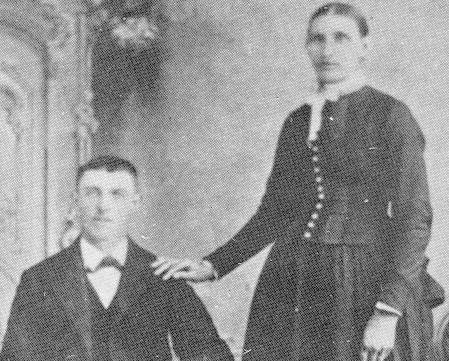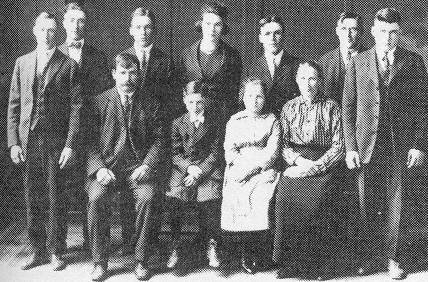
|
Carroll County IAGenWeb |
PHOTO GALLERY Other Pages:
Henry and Louise Ahrling and Family Girls: Agnes (Mrs. Henry J. Nieland), Frances (Mrs. Henry Olberding) and Gertrude Ahrling From: St. Bernard Parish 1880-1980 _________________________________________________________________
Henry J. and Agnes Ahrling Nieland From: St. Bernard Parish 1880-1980 _________________________________________________________________ Reverend Louis L. Akin "Today, January 24th, 1972, we are experiencing a very violent snow storm aggravated by high gusts of wind and 20 degrees below zero [temperatures]. Today most people are so situated that they [will] stay indoors and complain about the weather. It was not so with me as a youth. Many times, I have mounted my cattle pony, and out in the storm I went to round up the cattle and colts to bring them into shelter. We called such storms "Wooley-woosters"." "The thing that were most feared among the farmers in the days of my youth was the storm. Hardly a farmhouse was without a storm cave where the family huddled and waited and prayed as the ferocious storms swept the unprotected prairies." "I recall that a great, fearsome black cloud had formed with indications of a tornado in the West. Mother rushed us children to the cave. We stood in the doorway or stairway of the cave and watched Father who had been planting corn near the house head for home at full speed with old Jess and Roy hitched to the corn planter. He had thrown the planter to the ground and made the run for the cave trying to beat the storm. He left the team stand and made it just as the storm broke. Uncle Alex, Grandmother [Susan St. John] Akin's brother, was stone deaf and could not hear the rumbling of the storm as he puttered about the house. We watched him as he clung to the giant cottonwood tree several feet away from safety. His clothing was nearly ripped off, but he survived the ordeal with a laugh." "The storm past us without damage but several neighboring homes were damaged and some buildings destroyed. It had been but a short time before that the Pomroy cyclone had nearly wiped out the entire town with some deaths and several people hurt." "We were so isolated from the neighbors and people that it was a lonely life for a small boy. I am told that "where ignorance is bliss, it is folly to be wise". Not knowing what the outside world was like, I was quite content. I found solace in my mother who was always understanding and kind. I found companionship in the animals and pets about the place. Old Shep, the dog, the cats and little pigs were fun to play with. By giving a little pig special treatment and feed, it soon learned to know me and follow me about squealing for some special food. But of all the animals, I was most fond of the colts. I would some times teach them to drink from a nippled bottle. I would teach them little tricks, such as to shake hands with their front hoof, or to lie down on the grass where I would lie close to them. It seemed to me that those colts that I had petted and trained never forgot me. As they grew older, I broke them to ride and drive. In a way, I learned to enjoy the solitary loneliness, a desire that stayed with me for more than 80 years." "Old Kit, my first riding horse, was an average-sized, bay-roan horse with a lame right back leg. She was very gentle, and safe as a horse could be for us children to play with. My sisters had a side-saddle as was used by ladies in those days. I had a very small old saddle that my father had repaired though it had been discarded years before. Old Kit had one habit of which we learned to beware. When we tightened the saddle girth (belly-band, we called it) she would swing her head around and bite. I recall that one time she turned and caught me by the hair. We children would ride Old Kit about the homestead with as many on her back as could climb on - some times as many as four of us. There was always the risk taken by the back rider of being pushed off and left behind." "It became a standard joke among the women of the neighborhood to plan to meet one another "if the creeks don't rise". It was a common sight to see the Middle Raccoon River (the creek through the farmstead) swell until it covered thousands of acres of land. It just could not be crossed until the overflow had subsided. There was no drainage to carry the surplus water away. Most of the 400 acres south of the railway (where the Robert Akin farm is located) would be covered by most floods." "After a heavy rain, the cattle and colts must be looked after. Father would saddle old Sam (the buckskin mustang) and I would take Nell (a white Normandy breed mare) and ride from end to end of the pastures. Often, I now remember, the water would be belly deep on the horses. Sometimes the current was very swift, and I now believe that our horses knew more than we did. We let them pick their own way. Now and then they stumbled, but never dismounting their riders. If I had been thrown, it might have been just too bad for me because I could not swim and Father might be a half mile away. We would drive the cattle to the higher ground to wait until the water had subsided. Most every year, a few head would be lost. A few even were carried away by the current and we would find them in neighbors fields the next day." "While growing up at the Farmstead, countless peddlers tramped the roads carrying their packs on their backs filled with goods to sell to the farmers along the way. (That is the way that Younkers of Des Moines got started in the mercantile business.) Signs were put up around the Akin Farmstead warning the peddlers to keep out, but occasionally one would stop in regardless of the warning. Father would order them off the place and if they did not move on, one bullet near their feet persuaded them to move on and quickly. One day when father was in Carroll, one of my sisters decided she would see what all the peddler had in his pack. He was showing her a necklace when he leaned over and kissed her. Out of the house came Mother with a tea kettle of boiling water to throw on the peddler. At that moment, Father drove into the yard. One shot from the trusty revolver that raised a cloud of dust about the peddlers feet was a plenty. Off through the grove the peddler ran - I think a little faster than a bullet could travel. This became a family joke and I think that my sister never quite lived it down." This bio was written by Reverend Louis L. Akin, my grandfather. I made a few edits to correct some punctuation and grammar. Louis was a long time Carroll County resident although for some brief periods of his life, he ministered churches in other places. He was born in 1890 at the Akin farmstead which at that time consisted of the 640 acre section lying just south of Highway 30 and just east of N-33. In other words, it neighbors the Carroll Country Club to the east. He lived there all of his boyhood. Thus, the stories below illustrate what it was like growing up in rural Carroll County between 1895 and 1910. Louis died in 1984 at the age of 94 and is buried at the Glidden Cemetery. Larry Akin _________________________________________________________________ M/M Gerhardt Anstoeter 2-28-1874 Photo from: "1883 Halbur 1983 Memories of Yesterday Dreams of Tomorrow" ______________________________________________________________________ John Anthofer Sr. Family John Sr., Frank, Anna, Magdalena Mike, Geo., Henry, Mary, John, Wlm., Bernard Photo from: "St. Mary's-Willey Immaculate Conception Church 1882-1982" __________________________________________________________________________ |



